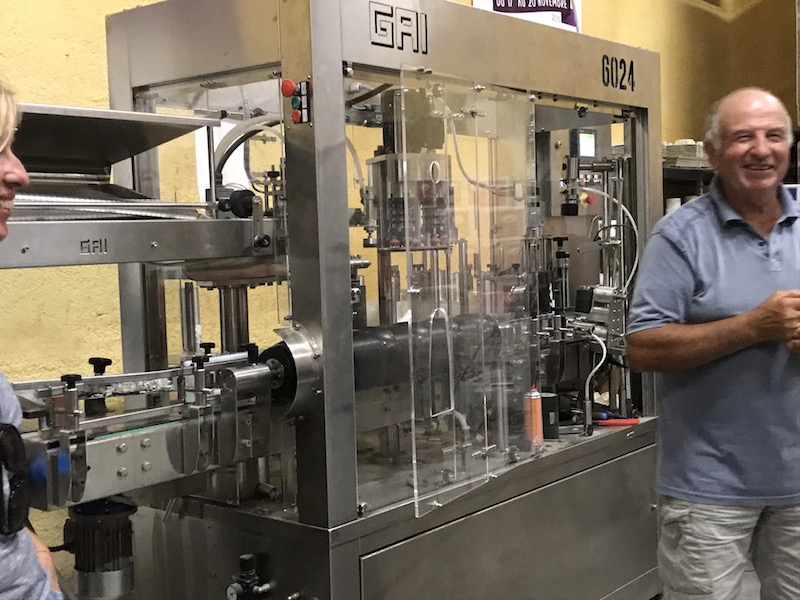Our Blog - Open House at Domaines La Croix des Marchands et Château Palvié
Another thing that we really enjoy living here is how close we are to wine country (well, almost all of France is wine country!) and the fact that there are SO many things to do around wine. For example, I just happened to be going through Facebook and happened to see an event advertised for an Open House at a vineyard nearby. It was only about 45 minutes away, and they had a guided visit to their Domaine, wine tasting, and a free oenology (study of wines) class.
I always have asked about the difference between "Château", "Domaine", and "Vignoble" in France. Vignoble is the easy one and it is just the vineyards themselves. Château actually means "Castle" in French although it is also used to indicate a palace or mansion. But if you look at wines, you'll see a huge number of wines that have "château" or "domaine"in their names. In general, they are somewhat used interchangeably to refer to a place where wine is made. However, there are some more specific differences going back to older times.
Domaine is an old Burgundian name for the accumulated holdings of one grower. Thus a domaine-bottled wine is one bottled by the producer. However, this is sometimes now indicated by "Mise en Bouteille" to indicate where it was bottled (au Château, for example). As mentioned, Château means "castle" or "mansion" and some wineries used Château to add prestige to their wines, since it brings to mind these large, beautiful mansions, which indicate wealth and power. Château is most commonly used by the wineries of Bordeaux, while the Domaine is typically associated with the wineries of Burgundy.
In 1857, a trademark law was adopted in France that impacted naming of wines. The use of "Château" became a way to make the winery's historic name unique and protectable. This is especially seen in Bordeaux where about 90% of Bordeaux's wine estates are "Château"-wines while the rest have usually taken other denominations such as Domaine, Mas, Clos, etc ..
Now, with that introduction, let's get to the Open House. This one was at a vineyard named Domaines La Croix des Marchands et Château Palvié. This is a family-run operation, I believe he said 3rd generation. There are two specific vineyards with two different "terroirs" (this indicates basically the environmental factors like soil and climate) which gives the grapes grown there specific characteristics. One section, the Domaines La Croix des Marchands, is made up of rocky/gravel soils and they product fruity and spicy wines. The other, Château Palvié, is a clay-limestone soil are with older vines that make richer and more powerful wines.

They are in the "Gaillac" area and there are specific grape varieties that are produced specific to Gaillac, as well as a few general varieties. For red varieties, Duras, Braucol, and Gamay are specific to Gaillac while Syrah is produced everywhere. Duras grapes make robust red wines with a peppery note. Braucol is originally from the Spanish Basque Country and has flavors like blackcurrant and raspberry. Gamay is an interesting grape, as it is used alone to make Gaillac Primeur, which is basically the same as Beaujolais nouveau but for the Gaillac region. It is available the 3rd Thursday of November and indicates the "first" wines available from that years harvest.


For whites, there is Mauzac, Muscadelle, and Loin de L'oeil. Mauzac is mainly grown in Gaillac and Limoux and prefer clay-limestone soils. They have the flavors of apple, blackberry and pear, and are sometimes harvested when they are overripe to make dessert wines. Loin de L'oeil (literally translated "far from the eye") make dry white wines as well as dessert wines with flavors of tropical fruit and honey. Lastly, Muscadelle has a very clean and simple aroma, normally floral notes, without a lot of other flavor profiles.

They talked about the various grape varieties and the different soils that they have for their vineyards, then we headed inside and talked about how they made the wine. There were various machines used during the harvest (which is done both by hand and by machine) and the pressing. There are various vats that are used to handle the fermentation and aging including stainless steel and oak barrels. It was a little hard to understand everything (it was in French) but it sounded like that some of the stainless steel vats are quite high-tech, allowing them to control the temperate and amount of movement of the wine within the vat. For example, for red wines, the fermentation happens with the stems and seeds included. These things tend to come to the top. If the wine isn't "stirred", then only a small amount of the juice actually is in contact with the stems/seeds, which means less tannins are in the wine.


He then showed a few machines used in the bottling process, from the machine that fills the bottles and puts in the cork (the first one), to the one that puts on the top sleeve (that he is holding) and labels the bottles (the 2nd machine). The bottles are then boxed by hand.





And then the wine tasting and the class! In fact, the oenology class covered much of the same information that they covered in the guided visit, except he went into a bit more detail on the various aromas and flavor profiles of the various grapes, terroirs, and wines.

We are actually looking forward to other events here, like the Gaillac Primeur and other open house events.